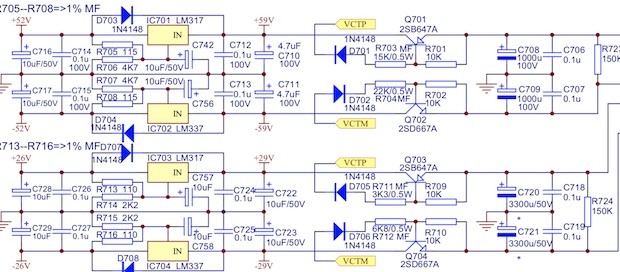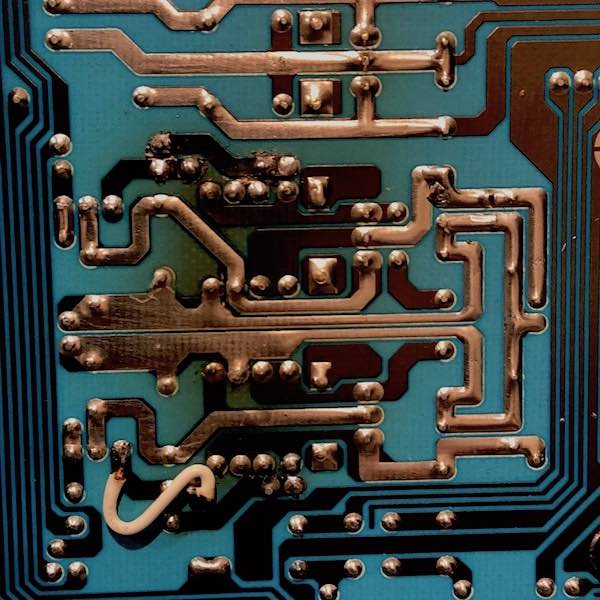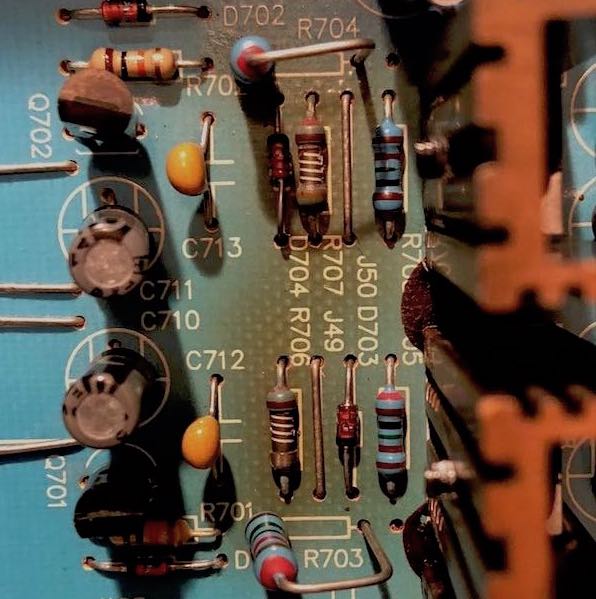NAD C162 preamp quiescent noise level suddenly went up
|
New member Username: BaskaransubrPost Number: 1 Registered: Oct-17 | I have had a NAD C162 preamp for many years (may be 10) now. It is feeding in to a NAD C270 stereo power amp. I noticed that it has started making a very noticeable level of quiescent noise. I have isolated it to the preamp. The noise level does not change with the volume level or which input is selected. I thought the power supply capacitors might have gone bad and went ahead and replaced them with high quality equivalents I got from DigiKey. However, that made absolutely no difference. I am wondering what I should look at next. Could it that some transistors in the signal path have degraded? I don't know if that is even a valid question. Can you suggest me some troubleshooting ideas? I have attached an audio recording of the sound from my speaker output.
|
|
|
Platinum Member Username: Jan_b_vigneDallas, TX Post Number: 18468 Registered: May-04 | . First, you need to tell us just what has changed. My Chromebook won't open your file but that doesn't really matter since you have not provided a "before" sample. Is the noise of a specific type? Hum - 60Hz noise - is typically a cap going bad. Coupling caps can go bad also as may any caps used to block DC at the outputs of a circuit. Buzz - 120Hz or higher noise - is generally a component other than a cap going bad or a change in the AC being fed to the component. It can also be the result of two electro-magnetic fields from two adjacent components interacting with each other. Generic white noise is, most often, increased by a change in the incoming AC feed. One issue with the AC feed will be, it is determined by your neighbor's house too. The average neighborhood has a group of distribution feeds which run to several houses but are all tied together by a common ground system. Whether it's your refrigerator that kicks on or your neighbor's, the noise may be entering your system through the common AC lines. Obviously, if anything has changed in your own house system, you could reasonably expect a change in the noise level of your pre amp. If a neighbor has added an antenna, there's a small chance you could be hearing reflected radio signals entering your pre amp's circuitry. That one's a pretty rare and unusual occurrence so I would be looking else where before I went chopping down a neighbor's satellite dish or a new cell tower in the middle of the night. Just know what we are increasingly surrounded by an ever growing RF field. 90% of the circuitry in your pre amp wants to act as an antenna. Have you done the basic housekeeping a system requires? If you aren't cleaning connection points and all analog controls at least once a year, oxidation of the contacts will created a weak link that often mimics a diode in its effects. Since a diode is a basic component of an old style crystal radio set, a diode effect can cause the connection to act as a radio tuner. Since there typically won't be a specific frequency the "tuner" clocks onto, it may be producing the white noise that exists between channels on the dial. Do your housekeeping and that may solve your problem. Otherwise, noises are very difficult to track down and even more so over a forum. Troubleshooting noises is most often a matter of trial and error while keeping very good records of what changes when you change something else and then applying logic to the results. The best advice I can offer from afar is to go through the system eliminating all possible sources of noise. That might mean moving the pre amp to another outlet or even another circuit on your service panel and it certainly should include a thorough cleaning of connectors and maintenance on your set up. If all that fails to resolve the issue, best next advice is to contact NAD. Get their input or simply take the pre amp to a service center and ask them to run diagnostics on the component. An estimate is requested and it will typically run less than $50. While they may not have a base line measurement, they do have the equipment to pin point any obvious defects within the circuitry. They may be able to locate a cold solder joint on the board and make the required repair. However, cold solder joints don't typically take ten years to open. Unless you have moved the pre amp recently, most solder joints are consistent even if they are not perfect. Transistors generally do not age, they can be consistent in their noise level for decades. It was/is a selling point against tubes, which will begin to age the moment you begin to use a tube. What would change over time is the circuit in front of the output device as resistors and caps will drift out of tolerance with the years' passing. If the output is designed to see, say, 2VDC and a resistor or cap has drifted sufficiently that it is now seeing 3VDC, you could expect a change in the performance of the output device. . |
|
|
New member Username: BaskaransubrPost Number: 2 Registered: Oct-17 | Jan - Thanks a lot for taking time to write such detailed reply. I really appreciate it. I am not sure why the attached audio file does not play in a browser. I will try to fix that if possible. I listen to a lot of music with very quiet passages and I have not heard the noise (more like white noise) until recently. So, I would say the baseline is inaudible. That is subjective, of course. The contacts are very clean. I do not see any oxidation. Moreover, I hear the noise with volume at 0 with or without any input connected. I have tried moving the pre-amp to different outlets within our home and that made no difference. I will take it to different location, like my work, to see if that makes a difference. |
|
|
Gold Member Username: MagfanUSA Post Number: 3465 Registered: Oct-07 | Have you experimented with the tone defeat switch? Same noise / problem with headphones? |
|
|
New member Username: BaskaransubrPost Number: 3 Registered: Oct-17 | I usually do not use the tone controls. Using it makes no difference. I get the same noise out of the headphone output. | |
|
Platinum Member Username: Jan_b_vigneDallas, TX Post Number: 18469 Registered: May-04 | . Not using a control is similar to not using a car. The likelihood a control will oxidize, or a car won't start, is greater the longer either sits in one position. The simple function of occasionally moving the control provides a small amount of cleaning action. Your routine maintenance/housekeeping would include cleaning all analog controls as well as the front and back side connectors. I can't speak to your specific NAD though it is likely built as most "modern" pre amps are constructed. Very few pre amps, integrated amps or receivers use the component's final output devices for drive to the headphone output. Typically, a small op amp, or a low wattage discrete circuit, is employed to output the low Voltages/Amperages required to drive most headphones to an adequate level. The outputs of the pre amp are typically muted when you insert the headphone jack but that is more for a convenience factor than anything related to wear and tear on the final output circuits. Take note though, the pre amp is still operational and heating and cooling cycles cause the aging process in most passive components such as resistors and caps. This probably doesn't lead you any closer to a diagnosis of your noise issue but it does indicate the problem would in most cases exist before the final output stages of the pre amp and ahead of the headphone output. That would lead anyone doing diagnostics to first look at shared componentry between the two output stages (headphones and pre out) and suspect the power supply as one of the most prominent circuits shared by both. If you contact NAD, this might be worth mentioning. I don't typically suggest most users get their hands too far inside any component since there are Voltages which can prove quite surprising and they can sit inside a cap for quite awhile after the unit has been powered down. And most users lack the test equipment to adequately troubleshoot things like noises anyway. But this might be of interest to NAD or a tech. It would be typical for the phono input to exhibit higher noise levels than any line level input but, is the noise level consistent between all of the high level inputs? Higher noise on one or more inputs could help to isolate the source of the noise. . |
|
|
New member Username: BaskaransubrPost Number: 4 Registered: Oct-17 | I spent more time examining the solder joints around the power regulator circuitry since the circuit board was discolored from heat. Found the traces to which resistors R703 and R704 were soldered where delaminating from the board and the resistors were wobbling. As I put the hot soldering iron on one of them, a piece of the trace broke off. I used a small jumper wire to complete the circuitry. I made sure that all other solder joints are good. The good news is that I do not hear the noise after doing the repair. I also noticed resistors R706 and R707 had deteriorated but their values matched what is specified in the schematics. I probably should replace them soon. Another interesting thing I observed. The resistors that I mentioned above and the transistors Q701 and Q702 got quite hot if I do not have an input selected, that is what happens to C162 when it is powered on; it powers up with no input selected. Same thing happens when it is put on standby mode. Once I select an input, those components do heat up but not as much as they do when no input is selected. Lately, I had been leaving the unit in stand by mode. I suspect that is what caused the failure. I am not sure if this model is prone to this problem or something happened to my unit to cause that. In any case, I am going to closely monitor my unit for the next few days as I use it. I have attached some photos to go with my description above.    |
|
|
Platinum Member Username: Jan_b_vigneDallas, TX Post Number: 18472 Registered: May-04 | . Well, it would be interesting to know more about why the area around the regulator got so hot it discolored the circuit board. Properly designed and executed circuits do not delaminate a board! Unless you can account for a reason the board would have shown signs of heat damage, this doesn't speak well for this design. I'm neither a NAD fan nor a NAD hater but I know a bit about how NAD builds and sells their products. I once heard a mechanic explaining why a Hyundai owner was having repeated problems with a window lift motor that seems appropriate here. He asked if the owner knew how they built a lower cost car, to which she answered, "No." The mechanic told her, "They use lower cost parts." It took her a minute to put two and two together. That might be what's going on here. NAD was in tight competition for the low cost bang for the buck component of the month when your pre amp was new. To build that sort of component companies cut corners and may use 1/4 watt parts when they should be using 1/2 watt parts. Like saving the few pennies on the Ford Pinto's muffler hanger, the long term results prove to be far more costly than just buying the better quality part in the first place. I think I'd be talking to NAD techs about this. . |
Main Forums
Today's Posts- Home Audio Forum
- A/V Receivers Forum
- Amps Forum
- Cassette Forum
- CD Players Forum
- CD Recorders Forum
- DAC & Transports Forum
- DVD-Audio & SACD Forum
- Equalizers Forum
- Integrated Amps Forum
- iPod Docks Forum
- MiniDisc Forum
- Mini Systems Forum
- Digital Music Systems Forum
- Phono Forum
- Preamps Forum
- Speakers Forum
- Subwoofers Forum
- Tuners Forum
- Home Video Forum
- Home Theater Forum
- Car Audio Forum
- Accessories Forum
- All Forum Topics